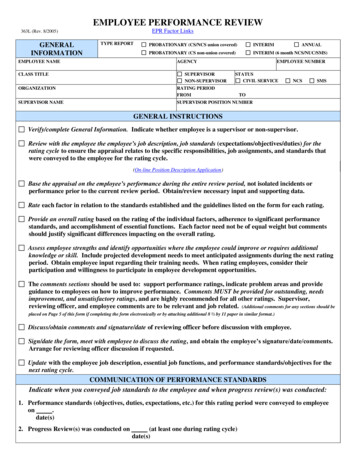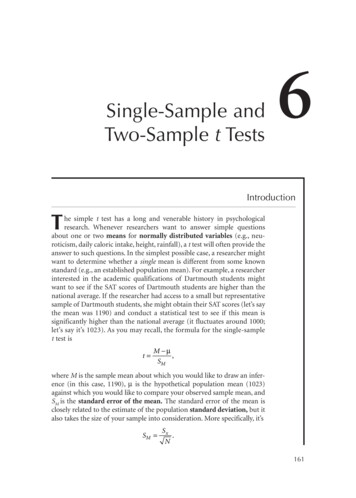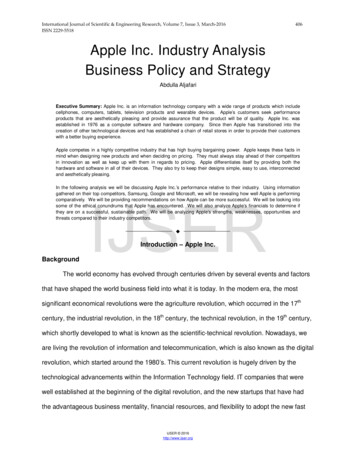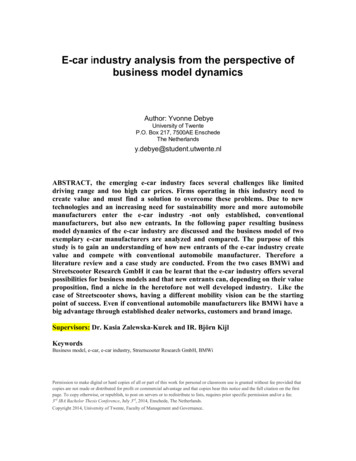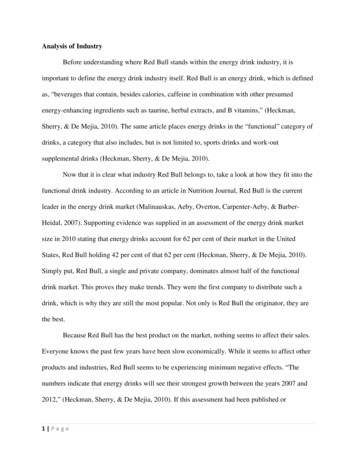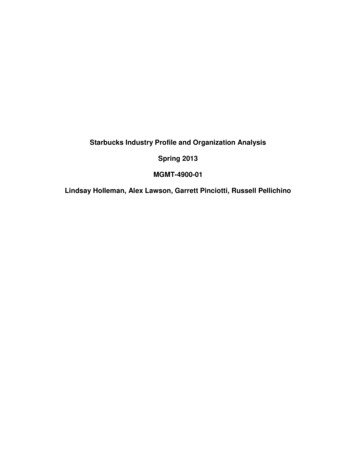
Transcription
This report contains an example of what you can expect if yourequest the services of the Clarion University Small BusinessDevelopment Center.Sample IndustryAnalysisAbout this report: Industry analysis reports contain a wealth ofinformation specific to industry type. This includes current trends,opportunities, threats, challenges, and critical issues. They also containfinancial benchmark information that may be used for comparisonagainst those in the industry. This report is a critical component ofunderstanding the current state of a given industry. The SBDC hasaccess to all 500 industry reports.
INDUSTRY PROFILEMachine Shops11.13.2017NAICS CODES: 33271SIC CODES: 3599Industry OverviewCompanies in this industry use machine tools to modify metal, plastic, and composite materials to producefinished products. No major companies dominate the industry.Worldwide, revenue for machine shops varies with manufacturing output. Because machine shops play amanufacturing support role, often operating as de facto subsidiaries of their customers, their work tends to belocal.The US machine shop industry includes about 20,000 companies with combined annual revenue of about 37billion.Competitive LandscapeDemand depends on manufacturing activity. The profitability of individual companies is linked to engineeringexpertise and operating efficiency. Larger shops have the ability to invest in advanced production machinery.Smaller shops can compete effectively by serving specialized customers, or by providing engineering services.The US industry is highly fragmented: the 50 largest companies generate about 10% of revenue.Products, Operations & TechnologyMachine shops are intermediaries in industrial production: generally, they receive unfinished parts or rawmaterials from a manufacturer, perform various operations, and return the parts to the manufacturer for furtherprocessing. They own and operate special machine tools that can perform a variety of operations, includingdrilling; boring (enlarging an existing hole); tapping (cutting threads inside a drilled hole); threading (cutting threadson a bolt); cutting; milling (removing material from a surface); and grinding (usually a finishing operation). Theseoperations involve material removal, frequently with great precision. The bulk of machine shop work is performedon metal, but plastics and composite materials are also machined.The machines that perform these operations are usually expensive and often computer-controlled. Machinetools vary by the type of operation they perform, the size of a piece they process, and the precision of theiroperations. Many are operated with computer numerical controls (CNC). Machine shops may own dozens ofdifferent machine tools produced by a variety of manufacturers. Modern machine shops are highly automated,with computer programs aiding the design of parts, as well as controlling the machines that are used tomanufacture them. Parts may be moved from one machine to another manually or using robotics. Aside from afew US companies, many major machine tool makers are German, Japanese, or Swiss.As the methods for machining have become more technologically complex, so too have the tools for managingshop operations. Many providers of customer relationship management (CRM) and enterprise resourceplanning (ERP) software, particularly those aimed at the small and mid-size business segments, offer applicationsuites tailored for the manufacturing sector. There are also software vendors dedicated specifically todeveloping tools for managing machine shop processes. Such software can help businesses submit bids, ordermaterials, schedule jobs, manage inventory, and track shipments.Four major operating activities in machine shops are pre-production, machine setup, actual production, andquality control. Machine setup for a particular job can be time-consuming and can hugely affect costs. Majormaterial costs for machine shops are the expensive, specially hardened l bits consumed in the variousoperations, including drilling bits, milling heads, cutting tools, and abrasives.TechnologyMore machine shops are expected to invest in robotics to enhance productivity, reduce operating costs, and
increase competitiveness. North American industrial robot shipments rose 10% in 2016 over 2015 levels,according to the Robotic Industries Association.Additive manufacturing, also known as 3D printing, is another technology with applications in machine shops.Additive manufacturing produces solid, three-dimensional objects by successively layering materials according toa digital design. Hybrid machine tools are being developed that combine additive and subtractive (cutting, milling,turning, and grinding) manufacturing technologies to offer machinery capable of a wider variety of parts withcomplex geometric shapes.Sales & MarketingMarketing for machine shops consists largely of direct contacts with local manufacturers. Because of the needfor close technical consultation between machine shops and customers, the work of most machine shops isusually confined to a very local area. New business may also come through requests for proposals (RFPs)from manufacturers familiar with the company. Customers can be in a wide variety of manufacturing industries.Because work is local, companies often have a large concentration of customers in the same industry.Major end-users include the aerospace, automotive, chemical, electronics, medical, oil and gas, and industrialmachinery industries. New work is often acquired through job bidding. While pricing is always a considerationfor new business, product quality and the ability to meet production timetables are often of greater concern.Management expertise is very important in properly pricing a bid, since the workability of materials, thecomplexity of machine setup, and the capabilities of individual pieces of machinery can vary substantially.Finance & RegulationMachine shops have large investments in machinery and equipment, including drill presses; lathes (turningmachines); and milling and grinding machines. Individual pieces of equipment may cost several hundredthousand dollars and can often be bought with financing provided by the manufacturer. On average, capitalexpenditures represent about 5% of sales. The industry is labor-intensive: average annual revenue peremployee is about 135,000.The US industry's working capital turnover ratio averages about 25%. Shops generally don't have largeinvestments in inventory, because customers typically provide materials. There is very little seasonality inproduction or cash flow, but the industry is susceptible to customer work stoppages and economic cycles, whichcan produce highly uneven and unpredictable cash flow. The value of inventory is usually about 10% of sales,and inventories turn about six times per year. Machine shop inventories tend to be split evenly between finishedgoods, work-in-progress, and raw materials.Demand for machining services depends on the level of US manufacturing activity, which can vary significantlyfrom year to year. Many machine shops depend directly on the health of a single end-use industry. The machineshop industry gets large amounts of business from the auto and aircraft industries and electronics and industrialmachinery producers. If a major customer or industry group closes or moves manufacturing operations, localmachine shops may experience a precipitous drop in demand, and collection periods and questionable accountsmay increase. Accounts receivable average about 50 days, but collection periods tend to be longer for smallercompanies (under 5 million in annual sales).Working Capital Turnover by Company SizeThe working capital turnover ratio, also known as working capital to sales, is a measure ofhow efficiently a company uses its capital to generate sales. Companies should becompared to others in their industry.
Financial industry data provided by MicroBilt Corporation collected from 32 different data sources and representsfinancial performance of over 4.5 million privately held businesses and detailed industry financial benchmarks ofcompanies in over 900 industries (SIC and NAICS). More data available at www.microbilt.com.RegulationBecause of the nature of working with metals, including the use of lubricants and solvents and the production ofsizable amounts of metallic wastes, machine shops can have environmental pollution problems, particularly withregard to ground contamination and toxic waste disposal. Some types of machining operations can alsorelease fine particles into the air, creating hazardous workplace conditions unless proper control steps are taken.The EPA administers environmental pollution regulations; OSHA administers workplace regulations.International InsightsThe global machine shop industry is dependent on the level of international manufacturing activity. However,because machine shops play a manufacturing support role, often operating as de facto subsidiaries of theircustomers, machine shop work tends to be local, and is less prone to crossing international boundaries thanmany other types of manufacturing.Demand for machine shop work within a given region or country is determined by demand for other manufacturedproducts further up the supply chain within that region. China, with its massive build-up of manufacturingcapacity and factory output, is a hotbed of machine shop growth. China is currently the offshoremanufacturing headquarters for manufacturers in the US, Canada, and Western Europe. But rising wages, arapidly growing middle class, and higher transportation costs may prompt some western manufacturers to lookfor low-cost manufacturing elsewhere, often much closer to where a product will be purchased or consumed. ForUS companies this "nearshoring" may mean moving offshore manufacturing operations from China to LatinAmerica, or even back to the US. For Western European manufacturers, outsourced operations might be movedfrom India or China to Eastern Europe. Increased investments in industrial automation technologies, includingrobotics, are also expected to fuel the nearshoring trend.The migration of manufacturing capacity as it follows global trends in wages and transportation costs will affectwhere demand for machine shop work rises or declines. Where machine shop work will be in high demand alsodepends on several key industries. In 2009, China surpassed the US as the world's largest automobile market.But after years of rapid growth, China's automotive market is expected to be relatively flat in 2017, according toScotiabank. Among emerging markets, Eastern Europe is expected to experience the strongest demand growthfor automobiles. Automotive markets in Russia and South America are forecast to rebound somewhat in 2017.Fabricated metal products are another industry that drives demand for machine shops. The rising affluence ofmany emerging economies will drive demand for machinery, appliances, and computers which would increasethe need for the specialized bolts, screws, nuts, and other machined or turned products made in machine shops.Change in Dollar Value of US Trade - US International Trade CommissionImports of machine shop products to the US come primarily from Taiwan, China, Japan,Germany, and Canada. Major export markets for US machine shop products includeMexico, Canada, China, UK, and Germany.
3327 BOLTS, NUTS, SCREWS, RIVETS, WASHERS AND OTHER TURNEDPRODUCTSRegional HighlightsIn the US, machine shops are most prevalent in states that lead in key customer segments such as aerospace,automotive, and energy. Measured by number of establishments, California, Texas, Ohio, Michigan, and Illinoisare the top states for machine shops; greater Los Angeles, Chicago, and Houston lead among metro areas.Human ResourcesMachine shop jobs require strong technical and engineering skills, but many employees are machineoperators who need only equipment-specific training. Average hourly pay for the industry is about the same asthe national rate.The safety record of the industry has improved with the greater use of computer-controlled machinery thatremoves the operator from the actual point of machining. However, the industry injury rate is still significantlyhigher than the national average.Industry Employment GrowthBureau of Labor StatisticsAverage Hourly Earnings & Annual Wage IncreaseBureau of Labor Statistics
Industry Growth RatingDemand: Depends on industrial productionNeed efficient operations and engineering expertiseRisk: Economic health impacts manufacturing demandQuarterly Industry Update11.13.2017Opportunity: US Manufacturing Technology Orders Rise - US orders for manufacturing technology, ademand indicator for machine shops, are expected to grow in 2018. Manufacturing technology orders increased14% in August 2017 compared to the same month a year earlier, according to the Association for ManufacturingTechnology (AMT). While monthly manufacturing technology orders have been uneven throughout most of 2017,both in terms of sales volumes and regional concentrations in demand, the AMT expects to see growth in 2018,both in the US and other major global markets. Among leading end-use markets, manufacturing technology ordershave been strong for job shops, power generation, and aerospace, but demand from the automotive industry hasslowed. Strong growth in corporate profits among durable goods manufacturers is expected to underpin sustainedinvestments in machinery as manufacturers seek to expand production capacity. Manufacturers may also bespurred into making equipment investments while interest rates are still low in anticipation of higher rates over thenext two years.Industry Impact - Amid rising profits for durable goods manufacturers and low interest rates, machine shopsmay invest in new metalworking machinery ahead of anticipated interest rate increases.8.14.2017Opportunity: US Manufacturing Growth Accelerates - US manufacturing activity, a leading demand indicatorfor machine shops, grew in June 2017 at the fastest pace in nearly three years, according to the Institute forSupply Management. Overall, manufacturers reported faster growth in production, new orders, employment, orderbacklogs, and exports. Of 18 manufacturing industries, 15 reported growth in June. Among the industriesreporting growth, several represent key customer groups for machine shops, including machinery; electricalequipment, appliances, and components; transportation equipment; chemical products; fabricated metal products;and petroleum and coal products. June's growth suggests that manufacturers are expanding even amid fadinghope for near-term government action on tax reform and infrastructure spending, according to Bloomberg.Industry Impact - If demand from the manufacturing sector remains robust, machine shops may invest in newequipment to increase productivity and production capacity.5.15.2017Opportunity: US Durable Goods Orders Rise - US orders for durable goods, a demand indicator for machineshops, increased 3.6% in the first three months of 2017 compared to the same period in 2016. A 5.9% rise inmetalworking machinery orders may signal that machine shops are making investments in new equipment amidimproved demand. Orders also improved in several manufacturing industries that represent key customer groups
for machine shops. Fabricated metal product orders grew nearly 6%, and new orders for industrial machinery sawgains of 4.3%. Orders for transportation equipment increased nearly 3%, led by motor vehicle bodies, parts, andnondefense aerospace products. New orders for mining, oil field, and gas field equipment declined 13.2%, but theenergy sector is showing signs of improvement. Recent reports by energy services firm Baker Hughes showsteady gains in oil rig counts as drillers continue to increase production. However, US 2017 first-quarter GDPgrew at the slowest rate in three years amid tepid consumer spending, particularly for expensive items includingautomobiles.Industry Impact - Machine shops may focus marketing efforts on customer industries that are showing signs ofsustained demand, including fabricated metal products, industrial machinery, and nondefense aircraft and parts.2.20.2017Opportunity: US Manufacturing Activity Gains Momentum - Continued expansion in the US manufacturingsector may signal a return to stronger demand for machine shop services. US manufacturing activity increasedin January 2017 for the fifth consecutive month, reaching its highest level in two years, according to the Institutefor Supply Management. Of 12 manufacturing industries reporting growth in January, several represent majorcustomer groups for machine shops, including plastics and rubber products; transportation equipment; machinery;petroleum and coal products; and fabricated metal products. Overall, manufacturers reported faster growth inproduction, new orders, and employment. A moderating of the strength of the US dollar and a stabilization incommodity prices may be contributing to higher demand for US manufactured goods, both at home and in exportmarkets, according to The Wall Street Journal. Manufacturers are also encouraged by the Trump administration'spromises to reduce taxes and implement regulatory reforms.Industry Impact - Sustained growth in the US manufacturing sector may benefit machine shop operators thatserve customers in the automotive, aerospace, machinery, and energy sectors.Industry IndicatorsUS durable goods manufacturers' shipments of fabricated metal products, an indicator of demand for machineshop services, rose 7.5% year-to-date in October 2017 compared to the same period in 2016.US steel mill product prices, an indicator of commodity steel costs for machine shops, rose 8.8% in November2017 compared to the same month in 2016.Industry ForecastRevenue (in current dollars) for US machine shops is forecast to grow at an annual compounded rate of 4%between 2017 and 2021. Data Published: September 2017First Research forecasts are based on INFORUM forecasts that are licensed from the Interindustry EconomicResearch Fund, Inc. (IERF) in College Park, MD. INFORUM's "interindustry-macro" approach to modeling theeconomy captures the links between industries and the aggregate economy. Forecast FAQs
CompaniesCompanyCountrySalesHypro, Inc.United States 295.85MBusche Performance Group, Inc.United States 175.69MNATIONAL MACHINE COMPANYUnited States 158.35MAts Assembly and Test, Inc.United States 150.55MCoast Composites, LLCUnited States 120.79MGoellner, Inc.United States 119.90MTsi Group, Inc.United States 116.36MAlex Products, Inc.United States 110.33MMorbark, LLCUnited States 107.20MModern Industries, Inc.United States 106.83MTSS Technologies, Inc.United States 104.65MTurbocam, Inc.United States 101.78MTriumph Structures-Los Angeles, Inc.United States 94.32MKimber Mfg., Inc.United States 87.86MIndustrial Piping, Inc.United States 87.77ML & H Industrial, Inc.United States 85.53MThunderbird LLCUnited States 84.98MSmw Mfg, Inc.United States 84.86MMICHIGAN PRODUCTION MACHINING INC.United States 81.04MInnovance, Inc.United States 76.63MHI-TEK MANUFACTURING, INC.United States 74.46MMagnetic Instruments Corp.United States 69.34MALLIED CHUCKER AND ENGINEERING COMPANYUnited States 69.19MFloturn, Inc.United States 67.83MLentros Engineering, Inc.United States 67.00MCustom Air Products & Services, Inc.United States 67.00MFulton Industries IncUnited States 64.69MConnor Manufacturing Services Inc.United States 62.52MChandler Industries, Inc.United States 60.00MDavid Price Metal Services IncUnited States 59.44MIndustry DriversChanges in the economic environment that may positively or negatively affect industry growth.Data provided by First Research analysts and reviewed annually
Energy Prices Change in crude oil and related energy pricesConstruction Spending Change in the overall level of commercial and residential construction spendingCommodity Prices Changes in prices for co
Analysis This report contains an example of what you can expect if you request the services of the Clarion University Small Business Development Center. About this report: Industry analysis reports contain a wealth of information specific to industry type. This includes current trends,
